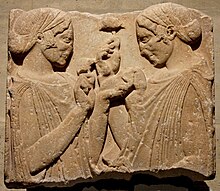Peplos


A peplos (Greek: ὁ πέπλος) is a body-length garment established as typical attire for women in ancient Greece by c. 500 BC, during the late Archaic and Classical period. It was a long, rectangular cloth with the top edge folded down about halfway, so that what was the top of the rectangle was now draped below the waist, and the bottom of the rectangle was at the ankle. One side of the peplos could be left open, or pinned or sewn together.[1] In Latin and in a Roman context, it could be called a palla.[2]
It should not be confused with the Ionic chiton, which was a piece of fabric folded over and sewn together along the longer side to form a tube. The Classical garment is represented in Greek vase painting from the 5th century BC and in the metopes of temples in the Doric order.
Spartan women continued to wear the peplos much later in history than other Greek cultures. It was also shorter and with slits on the side causing other Greeks to call them phainomērídes (φαινομηρίδες), the "thigh-showers".
Rituals[edit]
On the last day of the month Pyanepsion, the priestess of Athena Polias and the Arrephoroi, a group of girls chosen to help in the making of the sacred peplos, set up the loom on which the enormous peplos was to be woven by the Ergastinai, another group of girls chosen to spend about nine months making the sacred peplos. They had to weave a theme of Athena's defeat of Enkelados and the Olympian's defeat of the Giants. The peplos of the statue was changed each year during the Plynteria.
The peplos played a role in the Athenian festival of the Great Panathenaea. Nine months before the festival, at the arts and crafts festival titled Chalkeia, a special peplos would begin to be woven by young women. During the Panathenaea, the peplos was taken up to the Acropolis of Athens to be presented to the wooden statue of Athena Polias in the Erechtheion, opposite the Parthenon.[3] The main scene of the Parthenon frieze is believed, although not without disagreement, to represent this peplos scene during the Panathenaea.[3][4] The peplos had images of the mythic battle between gods and giants woven into its material and usually consisted of purple and saffron yellow cloth.
-
The Panathenaea peplos, from the Parthenon frieze
-
The Peplos Kore, colour reconstruction of statue of c. 530 BC
-
Athena wearing a luxurious peplos, one that uses a lot of fabric, 5th century BC
-
A wide peplos with the width gathered at the side to be used as sleeves
-
Nike wearing a peplos on top of a chiton, second quarter of 5th century BC
-
Fastening a peplos
-
Fastened
-
Pulling it over the head. Note remnants of red border
-
Woman wearing the fold of her peplos over her head, 2nd century BC
-
Wearing a peplos over a chiton, a later style
See also[edit]
References[edit]
- ^ "Ancient Greek Dress". Heilbronn Timeline of Art History, Metropolitan Museum of Art, 2000–2013. Retrieved 7 October 2013.
- ^ Radicke, Jan (2022). 3 palla – (1) precious cloak and (2) 'peplos'. Berlin: De Gruyter. doi:10.1515/9783110711554-019. ISBN 978-3-11-071155-4.
- ^ a b Titi, Catharine (2023). The Parthenon Marbles and International Law. Springer. pp. 44, 46. ISBN 978-3-031-26356-9.
{{cite book}}: CS1 maint: date and year (link) - ^ Neils, Jenifer (2001). "6". The Parthenon Frieze. Cambridge University Press.












